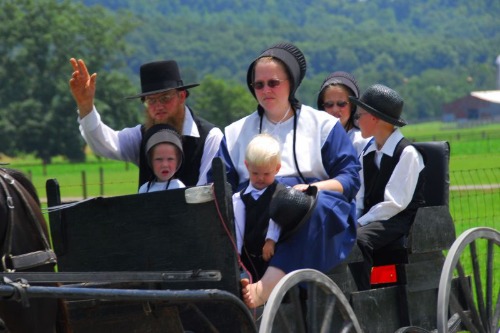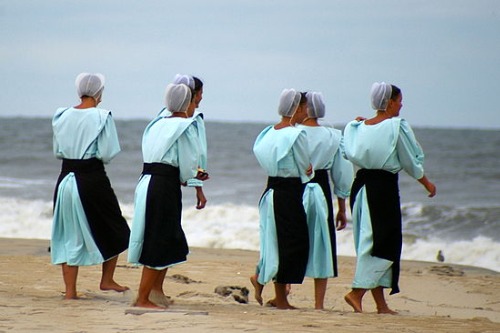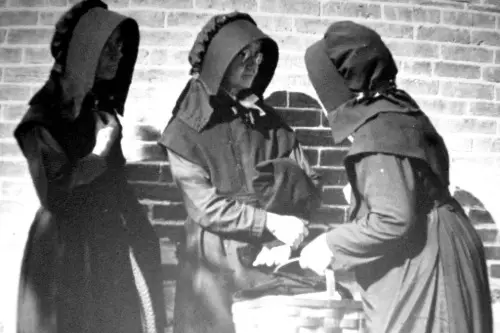1. The Amish Belief System and Photography

The Amish have a deeply rooted belief system that emphasizes simplicity and humility, which is one reason they reject modern technologies like photography. They believe that taking a photo may lead to vanity or self-centeredness, as it captures a person’s image for others to see. For them, the focus should be on humility and living a life away from worldly distractions, which is why any form of personal recognition is discouraged, according to PBS. Photography, in their eyes, goes against this principle, as it draws attention to an individual in a way that is contrary to their values of community and modesty.
Additionally, the idea of having one’s image captured is seen as potentially violating the idea of having an intimate relationship with God. The Amish believe that only God has the power to shape the human form, and photos are viewed as attempts to replicate or take control over something sacred. The act of photographing someone can be seen as an infringement on the natural order. In this way, they see it as a disrespectful act to turn someone into an object of attention or display.
2. The Relationship Between Technology and the Amish

The Amish are known for their selective approach to technology, adopting only what they believe won’t interfere with their faith or community. They use technology that serves the common good and can be integrated into their traditional lifestyle, according to Discover Lancaster. However, anything that they believe could disrupt the community’s closeness or lead to temptation, like photography, is strictly avoided. For them, avoiding technologies like photography keeps them in alignment with their values of simplicity and spiritual focus.
While some Amish communities may adopt certain technologies, such as phones or tractors, photography is one that is universally avoided. It isn’t just about the image itself but also the role technology plays in shaping relationships and individual identity. Many Amish people see modern technology as a tool that could foster unnecessary competition or pride. The rejection of photography is a statement against individualism, preferring instead to focus on the collective well-being.
3. What Happens If You Take an Amish Person’s Picture?

If you take an Amish person’s picture without their consent, the situation can vary depending on the individual and the community, according to Amish Country News. Typically, an Amish person would ask you to delete the photo immediately and may express disapproval in a respectful but firm manner. Since they believe that taking a photo is an infringement on their way of life, the request to remove the image is often non-negotiable. It’s important to understand that such a request comes from a deeply held religious belief rather than mere preference.
In some cases, depending on the severity of the violation, an Amish person may even confront you more directly. They could explain why photography is against their religious principles and kindly ask that you respect their wishes. While they usually avoid public confrontation, you should never underestimate the seriousness with which they view this issue. Such a confrontation, though uncomfortable, is not about hostility but about maintaining the sanctity of their way of life.
4. The Role of Community in the Amish Faith

Community plays an essential role in Amish life, and this is closely tied to their rejection of photography. The Amish place a significant emphasis on living a life that fosters strong community bonds, free from outside influences. Photography can be seen as a tool that disrupts the collective spirit by emphasizing individuality. This belief reflects their desire to stay focused on one another and avoid the divisiveness that could be caused by external distractions like photos.
Because the Amish reject the idea of individual fame or recognition, they prioritize communal identity over personal identity. The act of taking someone’s photo is not just a personal matter; it’s seen as something that could affect the whole group. If someone were to take a photo without permission, it could be perceived as a breach of their shared values. The community would likely address the issue not only to protect the individual’s dignity but also to preserve the group’s unity.
5. Respecting Amish Beliefs When Visiting Their Communities

If you are planning to visit an Amish community, it’s important to be aware of their rules and expectations, including the prohibition on photography. As a visitor, you should always ask permission before taking a photo of anything in or around an Amish settlement. Even in public spaces, respect for their privacy is key. Understanding that photography is a deeply ingrained part of their religious practice will help you avoid conflict and show respect for their way of life.
In some cases, if you take a photo without asking, you might be asked to leave the area or face further consequences. The Amish typically prefer to keep their lives private, and their desire to avoid photos is part of their commitment to spiritual integrity. By following their guidelines, you contribute to a peaceful and respectful interaction. Always approach their culture with an open mind and understanding of their unique beliefs.
6. Why Amish Do Not Pose for Photos

Unlike many people who might enjoy posing for a photo or being in the spotlight, the Amish reject the idea of being photographed because it encourages personal pride. They believe that posing for a picture can lead to an unhealthy focus on the self rather than on the community or faith, according to Ohio’s Amish Community. In their worldview, seeking attention or recognition in this way is sinful. As a result, even if you ask an Amish person for a posed photo, the answer will almost always be no.
This belief is rooted in their interpretation of modesty and humility, key elements of Amish life. They believe that by posing for a picture, one is making a deliberate attempt to draw attention to oneself. Since the Amish place such value on humility, anything that may detract from that can be seen as inappropriate. Their rejection of posing for photos is simply an extension of this deeply held belief.
7. The Impact of Photography on Amish Children

For Amish children, photography is seen as particularly damaging, as it can lead to pride and vanity at an early age. The idea of children growing up with the expectation of being photographed, or even knowing what it’s like to be in the spotlight, goes against Amish values. Childhood is meant to be a time of learning humility and focusing on the collective, not being singled out. Photography would introduce an element that could distract from these essential lessons.
In fact, some Amish parents actively discourage their children from engaging with media that promotes vanity, including photos. Children are often taught early on that photographs are a form of pride and should be avoided. This reflects the Amish belief that preserving a humble and community-centered upbringing is key to spiritual development. For them, it’s crucial that their children grow up without a sense of individualism tied to appearance.
8. The Use of Photography in Amish Weddings

Amish weddings are sacred, and the idea of capturing such an intimate moment with a photograph is often seen as inappropriate. Weddings, as major events in their community life, are meant to be private, sacred occasions where the focus is on faith and family. While outside photographers may not be present, some Amish communities may have an “official photographer” who stays discreet and avoids drawing attention to the event. The key here is that photography, if allowed, is done in a way that does not detract from the solemnity and communal nature of the wedding.
In cases where photography is involved, it’s typically very limited. There’s often no grand display of photos afterward, and those involved in the ceremony may not have personal portraits taken. This practice reinforces their desire for simplicity and modesty, ensuring that the day remains about the spiritual commitment between the couple, not the spectacle of the event. In the end, the Amish seek to maintain a clear distinction between their sacred moments and the outside world’s obsession with images.
9. The Impact of Outsiders Taking Photos of Amish People

Outsiders often make the mistake of taking photos of Amish people without understanding their cultural or religious significance. For many Amish, being photographed by someone from outside their community is invasive, as it may imply that their lives are meant to be on display. It also raises concerns about how these images will be used, whether for commercial purposes or simply to showcase their lifestyle to outsiders. This kind of exposure can feel disrespectful to the Amish because it commodifies their way of life.
Many Amish view such actions as a form of exploitation, particularly when the photographs are used in contexts that misrepresent or stereotype their culture. The misuse of their images can spread inaccurate portrayals of their community, which is something they work hard to avoid. The Amish are often portrayed in the media in ways that focus on their uniqueness, which they may find uncomfortable or misleading. As such, the act of outsiders taking photos can lead to a sense of alienation and disrespect.
10. The Amish and the Media

The Amish have historically kept their distance from the media, seeing it as another means by which their way of life might be distorted. With their rejection of photography, they also reject the idea of their lives being portrayed for public consumption. The media tends to focus on the Amish as exotic or unusual, often leaving out the deeper spiritual and community aspects of their culture. This portrayal reinforces the Amish desire to remain separate from the modern world, protecting their values from outside influence.
This media avoidance is partly a response to how their communities have been misrepresented in films, documentaries, and photo books. The Amish often prefer to live quietly without being subjected to the scrutiny or sensationalism that comes with being photographed or filmed. It’s not that they’re trying to hide from the world; it’s more about preserving their integrity and way of life in the face of outside interest. Their reluctance to appear in media ensures that their faith and culture stay true to their beliefs, free from the distortions of external attention.
11. Legal Consequences for Taking Amish Photos

While there is no nationwide law preventing someone from taking a photo of an Amish person, the Amish community does have its own rules and expectations. In some cases, taking a photo without permission can result in legal or financial repercussions, especially if it’s taken on private property. Depending on the community and the situation, the Amish could press charges if they feel their privacy or religious practices have been violated. However, this is rare, and most issues are handled privately within the community.
More often, the consequences of taking an Amish person’s photo without permission are social rather than legal. In some cases, a fine or informal social penalty could be imposed as a form of correction. However, the primary aim is to maintain respect for Amish customs and the sanctity of their way of life. Legal actions are typically a last resort, as the Amish generally prefer to resolve conflicts within their community rather than through legal systems.


